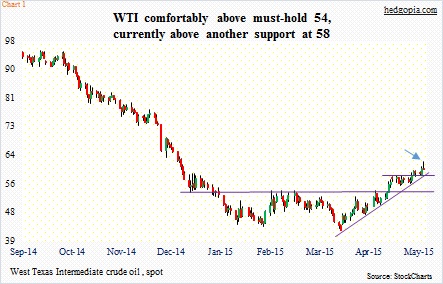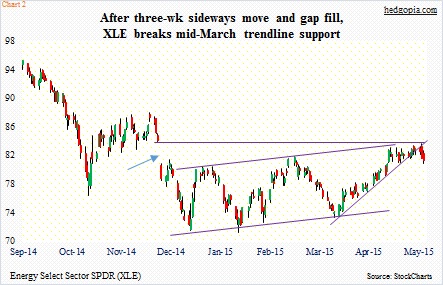Since spot West Texas Intermediate crude broke out of 54 mid-April, it has continued to add to gains, even as XLE, the energy SPDR ETF, has gone sideways/down.
Since that major push through four-month consolidation in the middle of April, the WTI again broke out of a two-week rectangle five sessions ago. The resulting measured-move target of 62 was hit yesterday. In the morning, the Energy Information Administration reported that U.S. crude stocks fell last week for the first time since the week ended January 2. Inventories dropped by 3.88 million barrels. Stocks at Cushing fell by 12,000 barrels. Although gasoline inventories rose.
The WTI, which opened flat yesterday, went on to rally up to 62.58, but bulls could not quite hang on to it. The crude is still above 58, where two support lines converge – broken straight-line resistance and mid-March rising trendline (Chart 1). As long as it trades above 54, double bottom is intact. So in a larger scheme of things, oil bulls are sitting pretty. Short-term is a different matter.
In less than two months, from the middle of March through the intra-day high yesterday, the WTI rallied 47-plus percent. Daily conditions in particular are grossly overbought. This in and of itself probably does not mean the WTI needs to rest. Nonetheless, yesterday’s session also produced a shooting star in the chart (blue arrow in Chart 1), which can be a sign of impending reversal.
The past several sessions in particular, XLE (81.32) has decoupled from the crude. Not that they move in tandem all the time, but the diverging action of late is noticeable on the right side of Charts 1 and 2.
On Tuesday, the ETF tried to rally on the coattails of crude, but the initial thrust higher got rejected at its 200-day moving average; the result was a bearish engulfing candle. The Tuesday reversal also filled the late-November gap (blue arrow in Chart 2).
Shorter-term moving averages are going sideways and likely on the verge of rolling over. Of the biggest weights, XOM makes up 15.1 percent of the ETF, CVX 13 percent, and SLB 7.7 percent. The former in particular is itching to go lower near-term.
This is setting up perfectly for income generation as was the case back on April 21. Once again, a bear call spread comes to mind. But here is the thing. Intermediate-term, XLE probably is an outright short, as conditions are way overbought. May 15th 82.50 weekly calls are selling for $0.50. A naked call write (normally a risky strategy) would create an effective short at 83 if the ETF manages to rally two-plus percent in the next seven sessions; otherwise, the $0.50 premium is kept.
Thanks for taking the time to read this post.

